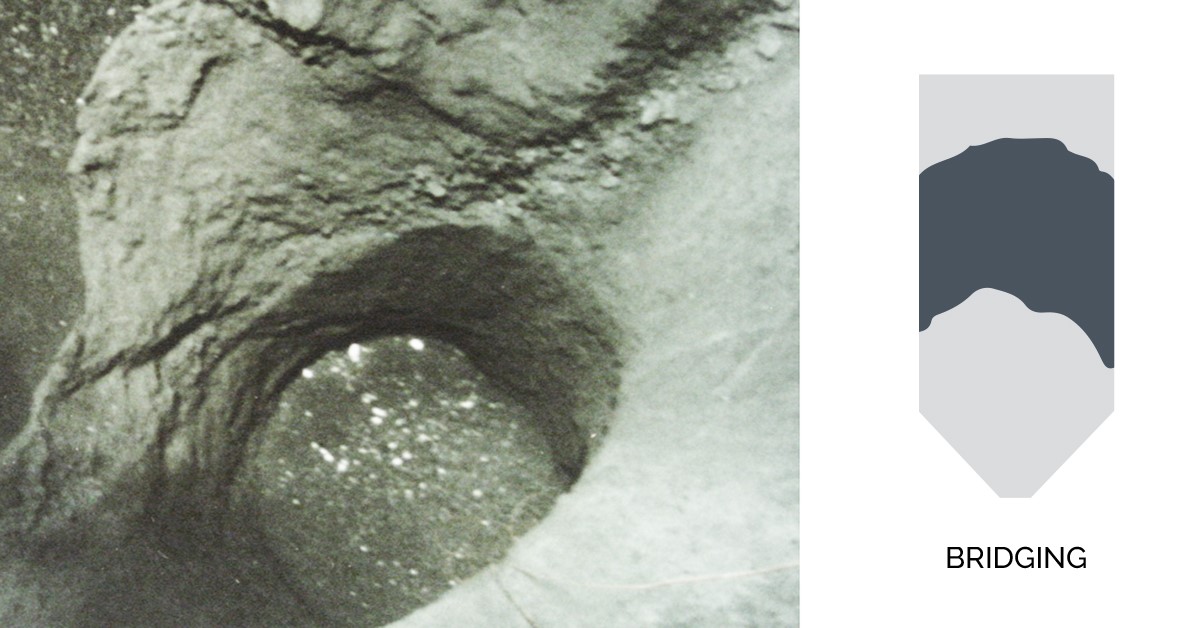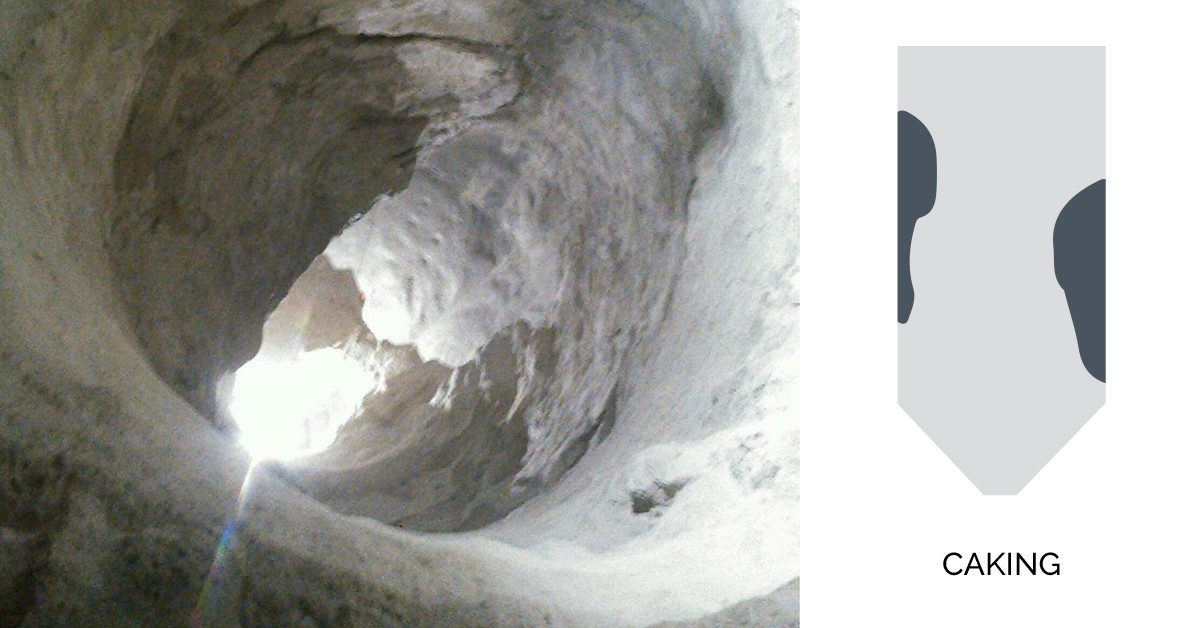- Planned downtime is always far more economical than unplanned downtime.
- Routine repair of a silo will cost you much less than an emergency repair.
- Small repairs are quicker and cheaper than a silo failure.
 .
. When material is poured into the storage silo it exerts pressure on the material under and around it, and with some materials, this surrounding pressure can cause a structural bond. This bond results in a bridging effect, where the bottom of the bridge empties but a dome arch remains, preventing any further material from flowing. As more material is dumped on top of the bridge the pressure exerted increases and the bonds holding the bridge together will actually become stronger.
When material is poured into the storage silo it exerts pressure on the material under and around it, and with some materials, this surrounding pressure can cause a structural bond. This bond results in a bridging effect, where the bottom of the bridge empties but a dome arch remains, preventing any further material from flowing. As more material is dumped on top of the bridge the pressure exerted increases and the bonds holding the bridge together will actually become stronger. Caking occurs when powder, such as detergents, fertilizers and salts, become cohesive after storage, forming agglomerates comprised of individual particles that are bonded together. Caking results when the magnitude of interparticle forces increase over time. The most common cause of caking is moisture migration due to temperature changes with materials that are soluble. Caking creates resistance to flow in silos and can result in residue on walls.
Caking occurs when powder, such as detergents, fertilizers and salts, become cohesive after storage, forming agglomerates comprised of individual particles that are bonded together. Caking results when the magnitude of interparticle forces increase over time. The most common cause of caking is moisture migration due to temperature changes with materials that are soluble. Caking creates resistance to flow in silos and can result in residue on walls.Prevention is the most effective method to ensure the integrity and continued operation of your silo. Regular maintenance and inspections can increase the life of your silo and ensure the safety of those working around your structures.
Though frequent inspections should be conducted in-house to catch warning signs early on it is important to understand the accompanying limitations. Many serious issues can only be identified by experienced silo inspectors or silo engineers during in-depth examination of empty silos free from material buildup.
The routine examination of your silo is effective in increasing facility safety and ensuring smooth operations only when it is conducted in conjunction with professional inspections as part of a regular preventive maintenance schedule. When used in place of professional services, in-house inspection, cleaning, and repair procedures increase safety risks. Failed silos can sometimes be repaired and some stored material can be recovered. However, companies often face additional costs from cleanup, possible environmental damage, injury, or loss of life.
While working on welding and fabricating metal bins for a concrete silo in December 2016, a fire broke out and resulted in the death of one crew member. After determining the crew did not have the required confined space permit, a general negligence action was settled for $1.75 million. (Michigan Lawyer Weekly, April 2017)
In August 2013, employees at an Ohio-based concrete facility attempted to remove material buildup of fly ash clumps in a clogged silo. After cleaning attempts of the interior using “a metal bar and air hose failed” an employee, who entered the silo without a lanyard and harness, died when a fire erupted. During the investigation, OSHA noted 10 serious safety violations, which resulted in a fine of $55,800. (OSHA News Release, November 2013)
Both of these accounts highlight preventable accidents where the necessary confined spaces permit was not held and the workers did not have the necessary safety training. Confined space permits and safety training are essential for safe inspections. While there are no inspection recommendations specific for silos, OSHA does have policies regarding confined space entry that are essential for interior inspections.
The effective inspections, however, depend on more than this permit. Inspectors must also have field experience and an understanding of the unique properties that effect silo material flow and structural integrity. Industry experience further enables trained silo and bin inspectors to recommend preventative maintenance to address issues before they become serious problems. Only inspectors with industry experience and proper silo engineering, design, and construction training can anticipate these issues to increase the effectiveness and safety of your silo.
It is recommended that you conduct professional inspections at two- to five-year intervals to help identify any issues that could lead to structural failure. Silo inspections should include examining the main aspects known to be potential areas of failure. These inspections should include the foundations, walls, cones, discharge configuration, floors, shelves, tunnels, and roofs.
The Mine Safety and Health Administration (MSHA) and OSHA have consistently emphasized a focus on silo processing and activity, but in recent years, one of their primary efforts has been on the importance of workplace safety and accident prevention. When it comes to the enforcement of safety policies, if there is an issue within a facility, the MSHA and OSHA are expecting to see a current silo inspection report for reference and assessment. Many insurance companies are also now requiring silo inspections on the facilities they insure.
Inspections can uncover problems that require immediate remediation. The most important thing to remember when conducting silo inspections is to consult a professional silo inspection and repair company if you discover anything alarming. You should also defer to a professional inspector if you do not have personnel with the necessary permits for closed space entry.
The importance of having regularly scheduled inspections by a professional silo company is even more evident in a recent case study in Florida where multiple discharge asymmetric flow failures were present.
To learn more, be sure to check out our full library of silo inspection videos on silo maintenance, inspection and repair on ![]()

